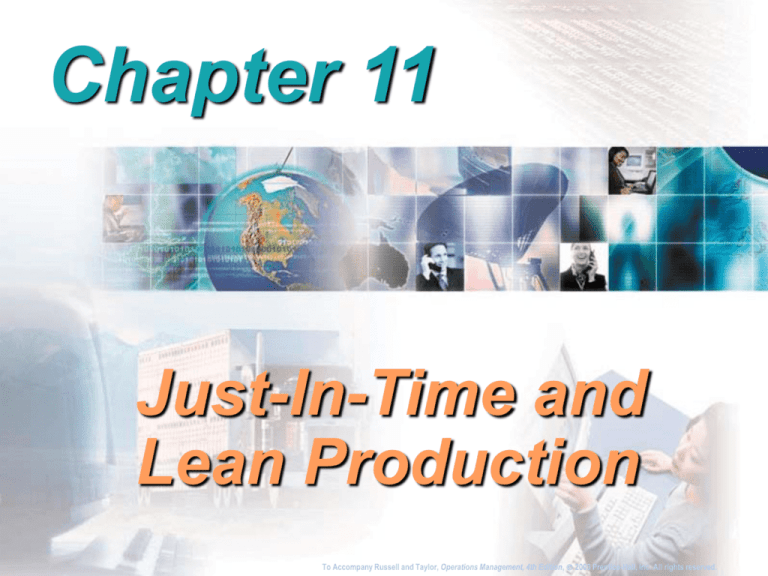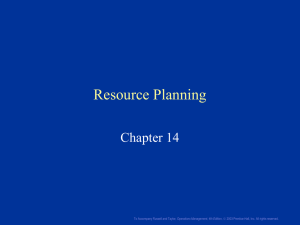
Chapter 11
Just-In-Time and
Lean Production
To Accompany Russell and Taylor, Operations Management, 4th Edition, 2003 Prentice-Hall, Inc. All rights reserved.
To Accompany Russell and Taylor, Operations Management, 4th Edition, 2003 Prentice-Hall, Inc. All rights reserved.
What is JIT ?
Producing only what is needed,
when it is needed
A philosophy
An integrated management system
JIT’s mandate:
Eliminate all waste
To Accompany Russell and Taylor, Operations Management, 4th Edition, 2003 Prentice-Hall, Inc. All rights reserved.
Basic Elements of JIT
1.
2.
3.
4.
5.
6.
7.
8.
9.
10.
Flexible resources
Cellular layouts
Pull production system
Kanban production control
Small-lot production
Quick setups
Uniform production levels
Quality at the source
Total productive maintenance
Supplier networks
To Accompany Russell and Taylor, Operations Management, 4th Edition, 2003 Prentice-Hall, Inc. All rights reserved.
Waste in Operations
Figure 11.1
To Accompany Russell and Taylor, Operations Management, 4th Edition, 2003 Prentice-Hall, Inc. All rights reserved.
Waste in Operations
Figure 11.1
To Accompany Russell and Taylor, Operations Management, 4th Edition, 2003 Prentice-Hall, Inc. All rights reserved.
Waste in Operations
Figure 11.1
To Accompany Russell and Taylor, Operations Management, 4th Edition, 2003 Prentice-Hall, Inc. All rights reserved.
Flexible Resources
Multifunctional workers
General purpose machines
Study operators & improve
operations
To Accompany Russell and Taylor, Operations Management, 4th Edition, 2003 Prentice-Hall, Inc. All rights reserved.
Standard Operating Routine
for a Worker
Standard Operating Routine
Sheet 1
Order of
Operations
:10
:20
:30
:40
Worker:
Cycle Time:
Operations time
:50
1:00 1:10
1:20
Russell
2 min
1:30
1:40
1:50
2:00
Pick up
material
Unload/
load
machine 1
Unload/
load
machine 2
Unload/
load
machine 3
Inspect/
pack
Figure 11.2
To Accompany Russell and Taylor, Operations Management, 4th Edition, 2003 Prentice-Hall, Inc. All rights reserved.
Cellular Layouts
Group dissimilar machines in
manufacturing cell to produce
family of parts
Work flows in one direction
through cell
Cycle time adjusted by changing
worker paths
To Accompany Russell and Taylor, Operations Management, 4th Edition, 2003 Prentice-Hall, Inc. All rights reserved.
Manufacturing Cell with
Worker Routes
Cell 1
Worker
1
Worker
2
Worker
3
Figure 11.3
To Accompany Russell and Taylor, Operations Management, 4th Edition, 2003 Prentice-Hall, Inc. All rights reserved.
Worker Routes Lengthened
as Volume Decreases
Cell 1
Cell 2
Worker
1
Worker
2
Worker
3
Cell 3
Figure 11.4
Cell 4
Cell 5
To Accompany Russell and Taylor, Operations Management, 4th Edition, 2003 Prentice-Hall, Inc. All rights reserved.
The Pull System
Material is pulled through the system
when needed
Reversal of traditional push system
where material is pushed according
to a schedule
Forces cooperation
Prevent over and underproduction
To Accompany Russell and Taylor, Operations Management, 4th Edition, 2003 Prentice-Hall, Inc. All rights reserved.
Kanban Production
Control System
Kanban card indicates standard quantity
of production
Derived from two-bin inventory system
Kanban maintains discipline of pull
production
Production kanban authorizes production
Withdrawal kanban authorizes movement
of goods
To Accompany Russell and Taylor, Operations Management, 4th Edition, 2003 Prentice-Hall, Inc. All rights reserved.
A Sample Kanban
To Accompany Russell and Taylor, Operations Management, 4th Edition, 2003 Prentice-Hall, Inc. All rights reserved.
The Origin of Kanban
a) Two-bin inventory system
b) Kanban inventory system
Bin 1
Kanban
Bin 2
Reorder
card
Q-R
R
R
Q = order quantity
R = reorder point - demand during lead time
Figure 11.5
To Accompany Russell and Taylor, Operations Management, 4th Edition, 2003 Prentice-Hall, Inc. All rights reserved.
Types of Kanbans
Figure 11.6
To Accompany Russell and Taylor, Operations Management, 4th Edition, 2003 Prentice-Hall, Inc. All rights reserved.
Types of Kanbans
Figure 11.6
To Accompany Russell and Taylor, Operations Management, 4th Edition, 2003 Prentice-Hall, Inc. All rights reserved.
Types of Kanbans
Figure 11.6
To Accompany Russell and Taylor, Operations Management, 4th Edition, 2003 Prentice-Hall, Inc. All rights reserved.
Types of Kanbans
Kanban Square
Marked area designed to hold items
Signal Kanban
Triangular kanban used to signal
production at the previous workstation
Material Kanban
Used to order material in advance of a
process
Supplier Kanbans
Rotate between the factory and suppliers
To Accompany Russell and Taylor, Operations Management, 4th Edition, 2003 Prentice-Hall, Inc. All rights reserved.
Determining Number of
Kanbans
average demand during lead time + safety stock
No. of Kanbans =
container size
dL + S
N =
C
where
N
d
L
S
C
= number of kanbans or containers
= average demand over some time period
= lead time to replenish an order
= safety stock
= container size
To Accompany Russell and Taylor, Operations Management, 4th Edition, 2003 Prentice-Hall, Inc. All rights reserved.
Determining the Number
of Kanbans
d
L
S
C
= 150 bottles per hour
= 30 minutes = 0.5 hours
= 0.10(150 x 0.5) = 7.5
= 25 bottles
(150 x 0.5) + 7.5
dL + S
N=
=
25
C
75 + 7.5
=
= 3.3 kanbans or containers
25
Round up to 4 (to allow some slack) or
down to 3 (to force improvement)
Example 11.1
To Accompany Russell and Taylor, Operations Management, 4th Edition, 2003 Prentice-Hall, Inc. All rights reserved.
Small-Lot Production
Requires less space & capital
investment
Moves processes closer together
Makes quality problems easier to
detect
Makes processes more dependent
on each other
To Accompany Russell and Taylor, Operations Management, 4th Edition, 2003 Prentice-Hall, Inc. All rights reserved.
Inventory Hides Problems
To Accompany Russell and Taylor, Operations Management, 4th Edition, 2003 Prentice-Hall, Inc. All rights reserved.
Lower Levels of Inventory
Expose Problems
To Accompany Russell and Taylor, Operations Management, 4th Edition, 2003 Prentice-Hall, Inc. All rights reserved.
Components of Lead Time
Processing time
Reduce number of items or improve
efficiency
Move time
Reduce distances, simplify
movements, standardize routings
Waiting time
Better scheduling, sufficient capacity
Setup time
Generally the biggest bottleneck
To Accompany Russell and Taylor, Operations Management, 4th Edition, 2003 Prentice-Hall, Inc. All rights reserved.
SMED Principles
1. Separate internal setup from
external setup
2. Convert internal setup to external
setup
3. Streamline all aspects of setup
4. Perform setup activities in
parallel or eliminate them entirely
To Accompany Russell and Taylor, Operations Management, 4th Edition, 2003 Prentice-Hall, Inc. All rights reserved.
Common Techniques for
Reducing Setup Time
Figure 11.8
To Accompany Russell and Taylor, Operations Management, 4th Edition, 2003 Prentice-Hall, Inc. All rights reserved.
Common Techniques for
Reducing Setup Time
Figure 11.8
To Accompany Russell and Taylor, Operations Management, 4th Edition, 2003 Prentice-Hall, Inc. All rights reserved.
Common Techniques for
Reducing Setup Time
Figure 11.8
To Accompany Russell and Taylor, Operations Management, 4th Edition, 2003 Prentice-Hall, Inc. All rights reserved.
Uniform Production
Results from smoothing production
requirements
Kanban systems can handle +/- 10%
demand changes
Smooths demand across planning
horizon
Mixed-model assembly steadies
component production
To Accompany Russell and Taylor, Operations Management, 4th Edition, 2003 Prentice-Hall, Inc. All rights reserved.
Mixed-Model Sequencing
Example 11.2
To Accompany Russell and Taylor, Operations Management, 4th Edition, 2003 Prentice-Hall, Inc. All rights reserved.
Quality at the Source
Jidoka is authority to stop production
line
Andon lights signal quality problems
Undercapacity scheduling allows for
planning, problem solving &
maintenance
Visual control makes problems visible
Poka-yoke prevents defects
To Accompany Russell and Taylor, Operations Management, 4th Edition, 2003 Prentice-Hall, Inc. All rights reserved.
Visual Control
Figure 11.9
To Accompany Russell and Taylor, Operations Management, 4th Edition, 2003 Prentice-Hall, Inc. All rights reserved.
Visual Control
Figure 11.9
To Accompany Russell and Taylor, Operations Management, 4th Edition, 2003 Prentice-Hall, Inc. All rights reserved.
Visual Control
Figure 11.9
To Accompany Russell and Taylor, Operations Management, 4th Edition, 2003 Prentice-Hall, Inc. All rights reserved.
Kaizen
Continuous improvement
Requires total employment
involvement
Essence of JIT is willingness of
workers to
Spot quality problems
Halt production when necessary
Generate ideas for improvement
Analyze problems
Perform different functions
To Accompany Russell and Taylor, Operations Management, 4th Edition, 2003 Prentice-Hall, Inc. All rights reserved.
Total Productive
Maintenance (TPM)
Breakdown maintenance
Repairs to make failed machine operational
Preventive maintenance
System of periodic inspection & maintenance
to keep machines operating
TPM combines preventive maintenance &
total quality concepts
To Accompany Russell and Taylor, Operations Management, 4th Edition, 2003 Prentice-Hall, Inc. All rights reserved.
TPM Requires
Management to:
Design products that can be easily
produced on existing machines
Design machines for easier operation,
changeover, maintenance
Train & retrain workers to operate machines
Purchase machines that maximize
productive potential
Design preventive maintenance plan
spanning life of machine
To Accompany Russell and Taylor, Operations Management, 4th Edition, 2003 Prentice-Hall, Inc. All rights reserved.
Supplier Policies
1. Locate near to the customer
2. Use small, side loaded trucks and ship
mixed loads
3. Consider establishing small warehouses
near to the customer or consolidating
warehouses with other suppliers
4. Use standardized containers and make
deliveries according to a precise delivery
schedule
5. Become a certified supplier and accept
payment at regular intervals rather than
upon delivery
To Accompany Russell and Taylor, Operations Management, 4th Edition, 2003 Prentice-Hall, Inc. All rights reserved.
Benefits of JIT
1. Reduced
inventory
2. Improved quality
3. Lower costs
4. Reduced space
requirements
5. Shorter lead time
6. Increased
productivity
7. Greater flexibility
8. Better relations
with suppliers
9. Simplified
scheduling and
control activities
10. Increased capacity
11. Better use of
human resources
12. More product
variety
To Accompany Russell and Taylor, Operations Management, 4th Edition, 2003 Prentice-Hall, Inc. All rights reserved.
JIT Implementation
Use JIT to finely tune an operating
system
Somewhat different in
USA than Japan
JIT is still evolving
JIT isn’t for everyone
To Accompany Russell and Taylor, Operations Management, 4th Edition, 2003 Prentice-Hall, Inc. All rights reserved.
JIT In Services
Competition on speed & quality
Multifunctional department store
workers
Work cells at fast-food restaurants
Just-in-time publishing for
textbooks
Construction firms receiving
material just as needed
To Accompany Russell and Taylor, Operations Management, 4th Edition, 2003 Prentice-Hall, Inc. All rights reserved.







